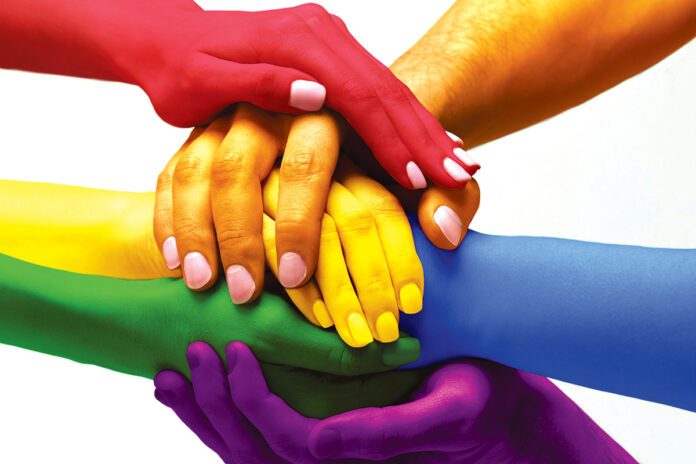Trans people face a unique quandary, and creating a welcoming workplace will go a long way to helping them feel valued at work
Words by Sakshi Dhingra

From a young age, it has been drilled into us that pink is a more feminine colour and blue is innately masculine. Things haven’t really changed much in the years that followed, but of late there has been a noticeable trend to be more welcoming of people of all stripes and orientations, in order to create a more diverse social order.
Today, organisations are talking about Diversity and Inclusion and due to growing awareness, most global companies want to showcase the importance of equality in their hiring trends. The question must be asked, though: what will it take to stand out and protect, safeguard, and nurture those that choose to do things differently?
Understanding Gender Identity and Expression

People use diverse terms to convey who they are and how they wish to be identified. Although the terminology described below is widely used, we recognise that their definitions, as well as those of others, are always evolving. Furthermore, keep in mind that people are the best experts on their own identities and should always be asked how they would like to be addressed. Here’s a tiny table to help you learn more about different expressions:
Is stigma for real?
Have you thought about why it is difficult for the transgender community to live a normal life, and why they frequently experience stigma and prejudice? The way in which people have been guided into comprehending and expressing gender is the answer to the question. Gendered behaviour is systematically induced in young children. Young boys and girls are pushed to act in stereotypically gendered ways, as mentioned above.
Moreover, they are chastised for acting in non-normative ways. Likewise, girls are taught to behave and conduct themselves in a specific manner. Consider the custom of giving baby boys and girls blue and pink gifts, respectively. All these factors lead an individual to believe that they have a certain way that has been assigned to their gender; and anything that is slightly different from the ways that have been taught to them, they start doubting and stigmatising it.
In order to gain parental approval and later acceptance from their peers, children try to conform to gender expectations. This is how the problem begins at the root.
Gender norms, and the underlying issue
Gender sensitisation is possibly the most fundamental behavioural change organisations must induce. These social principles, which define how one should behave or dress without being judged, is something that we need to rethink. Transgenders have faced innumerable comments and share massive discomfort when they co-exist in the same ecosystem as others.

A survey in recent years has revealed that an astounding 75% have tried hiding their identities to avoid any kind of mistreatment at work. This includes hiding their gender identity, correcting people in the usage of pronouns for them, or delaying gender transition. Unfortunately, many of them have even attempted dropping out of their employment.
The worst has been reported, including trans employees being forced to resign, having difficulty securing jobs, and being denied or delayed promotions. A considerable percentage also reported being ill-treated at the office over trivial matters, such as being denied access to washrooms or not having bathrooms aligned with their gender identity. All these factors have collectively contributed to disappointment for the transgender community.
Trans-inclusive workplace
Every employee must be treated with basic respect, equal chances, and growth plans. Individual policies for everyone, regardless of gender preference. Here are some ideas to get you started if you want to create a workplace that is supportive of transgender people.
1. Reducing gender discrimination in the employment process
2. Developing acceptable dress code policies
3. Assisting with gender changes
4. Developing trans-specific diversity training
5. Employ interventions to improve adaptation.
Let’s look at this more closely.
Gender prejudice when hiring a candidate
When hiring, a recruitment team shouldn’t judge someone on the candidate’s gender. Instead, ponder the value the person will add to the organisation, or how much of a fit they are for the role at hand. Personal biases should not be encouraged.

Appropriate dressing
All of us have the freedom to decide what we want to wear or choose to be comfortable with. Personal comments on dressing should be discouraged, and the standard policy of dressing should be applicable to all employees. Small steps to making each employee feel equal go a long way. Like they say, “it starts from home”, in this case our offices.
Gender transition counselling
We’ve read articles that speak of psychology and mental health being the most crucial part of the transition. Organisations and HR leaders should arrange for counselling sessions along with supporting the individual, respecting the choices they have made. A sense of belonging takes us a long way.
Here’s how you can assist them throughout the transition period:
Medical advantage
Equal rights and equal compensation should be emphasised. Simply talking is not enough; action is the proof of the pudding. Standard policy, with no changes, should be communicated to all workers, regardless of gender.

HR as a springboard
Human Resources personnel should understand the goals and needs of the people of the organisation, ensuring that everyone is taken care of emotionally and mentally. This goes beyond the job role or organisational goals, to help people in every manner that is feasible.
Team managers
Managers are often brutally honest in their remarks, which can affect employees. Hence, they must use gender sensitive language and avoid personal assaults. There is a fine line between doing the job and making someone uncomfortable. Major leadership lessons include accepting the team for who they are.
In conclusion
People can only work to their greatest ability when they feel completely welcome, trusted, and committed to their organisation. The same holds true for trans personnel. However, very few businesses have successfully fostered an inclusive workplace for those who don’t identify with social gender stereotypes.

We hope to have presented the preventive measures elaborately and our suggestions will contribute to a positive change. Employers who get this right go beyond merely being business savvy. Additionally, they are creating a business legacy that prioritises respect for human dignity and views doing the right thing as important. In this way, they can assure their employees that they are integral and essential for business success.


